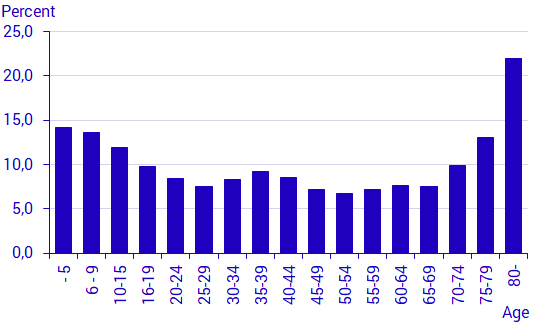Income and taxes: Income mobility 2000-2019
Persistent low income common among foreign born persons
Statistical news from Statistics Sweden 2021-03-25 9.30
Among Sweden’s population in 2019, just over 15 percent were at risk of poverty. Two thirds of those people, nearly 10 percent of the population, were at persistent risk of poverty. This means that they were at risk of poverty in 2019 and during at least two of the three preceding years. The percentage of persons at persistent risk of poverty has increased somewhat in recent years.
The percentage of persons who were at persistent risk of poverty varies widely between different groups. Among children below 10 years, the proportion is about 14 percent and among those over 80 years the proportion is 22 percent. In the ages 45–60 years, the proportion is 7 percent.

One in five foreign born persons were at risk of poverty, while among Swedish born persons, this proportion was 7 percent.
Among foreign born persons, there are also major differences between regions of birth. One in three people born in Africa was at persistent risk of poverty and among people born in Asia the corresponding figure was one in four. Among people born in Europe, this percentage was around 15 percent. The differences between people born in a Nordic country and people born in the rest of Europe are minor.
Persistent risk of poverty is generally less common among foreign born persons who have lived in Sweden for a long time compared with those who have lived in Sweden a shorter period of time. Among persons who have lived in Sweden for more than 20 years and are born in Africa or Asia, 18 percent had a persistently low income.
Among foreign born children living in Sweden, more than 40 percent were at persistent risk of poverty, compared with 6 percent among children born in Sweden and who have two Swedish born parents.
Gainfully employed persons are seldom at persistent risk of poverty; the proportion in this group was 2 percent, while one in four people not gainfully employed, such as students, unemployed persons and ill persons, were at persistent risk of poverty.
Danderyd and Vaxholm municipalities had the lowest persistent at-risk-of-poverty rate in 2019, at about 3 percent. The persistent at-risk-of-poverty rate was higher than 14 percent in approximately 50 out of Sweden’s 290 municipalities.
Definitions and explanations
Persons at persistent risk of poverty refers to persons living in a household where the equivalised disposable income is below 60 percent of the national median during the reference year and during at least two out of the preceding three years. This is the same definition that Eurostat uses to calculate the persistent at-risk-of-poverty rate.
Statistical Database
More information is available in the Statistical Database
Feel free to use the facts from this statistical news but remember to state Source: Statistics Sweden.
